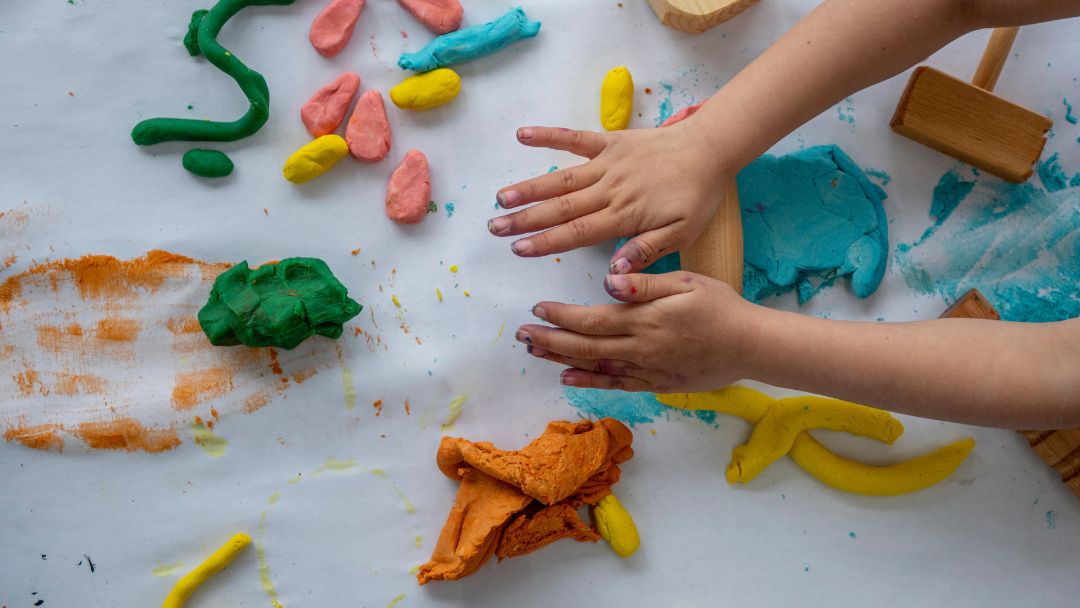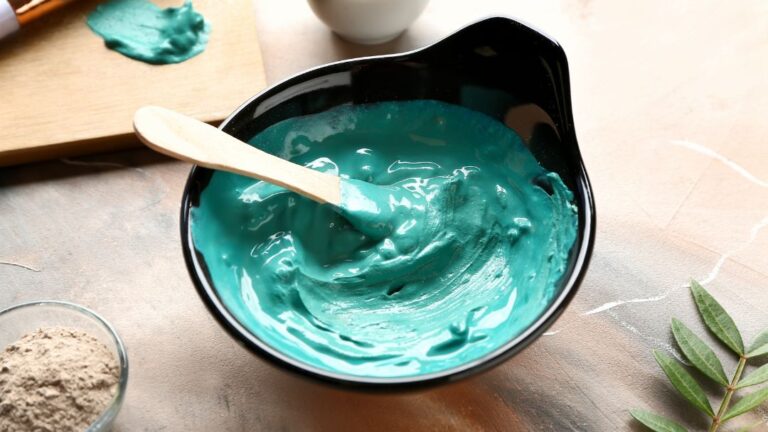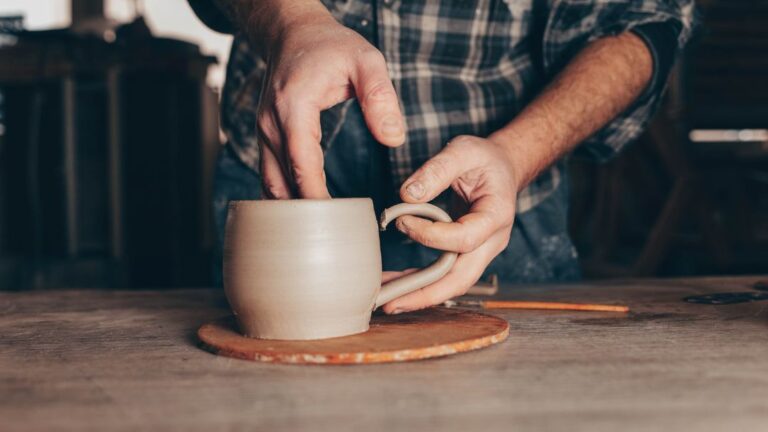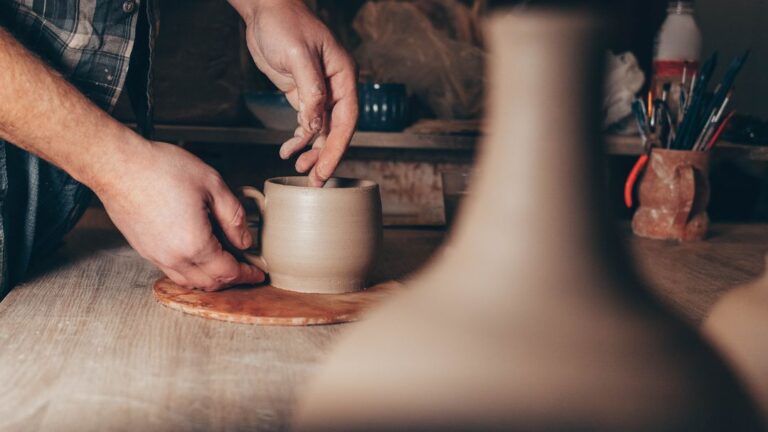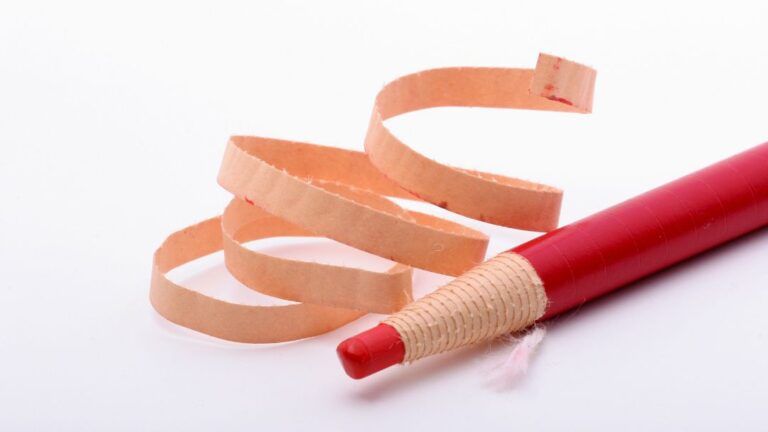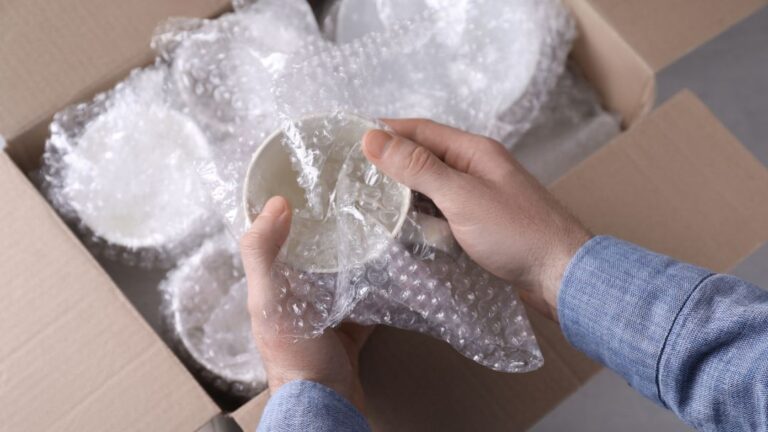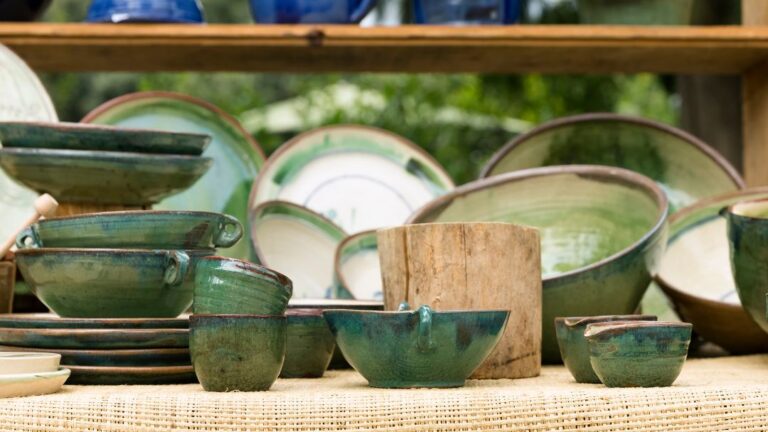How to Use Paper Clay: Mastering the Art
To use paper clay, firstly, mix equal parts of paper pulp and clay. Then, shape, mold, and let it air dry.
Paper clay is a versatile material that combines the pliability of clay with the lightweight texture of paper. It is an excellent choice for artists and craft enthusiasts looking to create unique sculptures, pottery, and decorative items.
This environmentally friendly material is easy to work with and can be shaped, molded, and textured.
Once dry, it can be painted, varnished, or even fired in a kiln if desired. We will explore the various techniques and tips for using paper clay effectively to achieve stunning and long-lasting results.
Whether you are a beginner or an experienced artist, this guide will help you unleash your creativity and explore the endless possibilities of paper clay.
Understanding Paper Clay
Paper clay is a versatile material for creating pottery. Learn how to use it for sculpting and hand-building in this informative guide.
What Is Paper Clay?
Paper clay is a versatile art medium that combines paper fibers with clay to create a unique material with distinctive properties and characteristics. It is a popular choice among artists due to its lightweight nature and its ability to be easily molded and shaped.
Paper clay is also known for its ability to adhere well to various surfaces and its compatibility with other clay types. With its unique composition, paper clay offers endless possibilities for artistic expression.
Benefits Of Using Paper Clay In Art Projects
- Versatility: Paper clay can be used in various art projects, including sculpting, pottery, and mixed media artworks. Its ability to be shaped, molded, and manipulated makes it a perfect choice for artists looking to experiment with different techniques.
- Lightweight: One of the major advantages of paper clay is its lightweight nature. This makes it easy to handle and less prone to cracking or breaking during the drying process. It also allows for larger and more intricate creations without the added weight.
- Adhesion: Paper clay has excellent adhesion properties, allowing it to bond well with other materials, such as wood, metal, and fabric. This opens up endless possibilities for mixed media projects and the creation of unique textures and effects.
- Drying time: Compared to traditional clay, paper clay has a much shorter drying time. This means that artwork made with paper clay can be completed faster and ready for further embellishments or finishes in a shorter period.
- Eco-friendly: Paper clay is made from recycled paper fibers, making it an eco-friendly choice for artists. By using paper clay, artists can reduce their environmental impact while still creating stunning artworks.
Key Properties Of Paper Clay
- Fiber content: Paper clay is made by incorporating paper fibers, such as those from newspapers or paper scraps, into traditional clay. This fiber content gives paper clay its distinctive properties, such as increased flexibility, reduced shrinkage, and improved crack resistance.
- Plasticity: Paper clay has excellent plasticity, allowing artists to easily mold and shape it according to their creative vision. It can be rolled, pinched, pressed, and carved, making it suitable for both intricate details and larger-scale creations.
- Texture: Artists can create various textures with paper clay, ranging from smooth and refined surfaces to rough and textured finishes. The fibers in the clay provide a unique visual and tactile element that adds depth and interest to the artwork.
- Firing: Paper clay can be fired in a kiln just like traditional clay. However, it is important to follow specific firing instructions to ensure the best results. Lower firing temperatures are generally recommended to prevent the paper fibers from burning out and to maintain the integrity of the artwork.
- Finishing: Once the paper clay artwork is fully dry, it can be painted, glazed, and finished just like any other ceramic piece. The smooth surface of the clay allows for various finishes, from matte to glossy, depending on the desired effect.
Paper clay is a versatile art medium that offers unique advantages for artists. Its lightweight nature, ability to bond well with other materials, shorter drying time, and eco-friendly composition make it a popular choice for both beginners and experienced artists.
With its distinctive properties and capabilities, paper clay allows for endless creativity and artistic expression.

Preparing Paper Clay For Use
To prepare paper clay for use, start by tearing or shredding the paper into small pieces. Soak the paper in water until it becomes soft, then mix it with clay until the desired consistency is achieved. Add water as needed and knead the clay to ensure it is well blended.
Now, you can mold and sculpt with your paper clay.
Choosing The Right Paper Clay For Your Project
- Porcelain paper clay: Ideal for intricate and delicate projects due to its smooth texture and fine grain.
- Stoneware paper clay: Perfect for sculpting and hand-building larger pieces as it has excellent strength and durability.
- Earthenware paper clay: Great for beginners as it is easy to work with and dries quickly.
- Fiber paper clay: Offers a lightweight option for creating larger sculptures or when weight is a concern.
Essential Tools And Materials Needed For Working With Paper Clay
- Paper clay: Choose the appropriate type based on your project’s requirements.
- Water: Used to soften and moisten the clay.
- Mixing container: A bowl or bucket to mix the clay and water.
- Measuring tools: Cups or a scale to ensure accurate proportions when mixing.
- Plastic wrap: Keeps the clay from drying out during breaks in your work.
- Texture tools: Various objects to create textures and patterns on the clay’s surface.
- Sculpting tools: Knives, spatulas, and brushes for shaping and detailing.
- Sandpaper: Smooths rough edges and surfaces.
- Kiln or oven: Required for firing the clay, depending on the type you are using.
- Protective gear: Gloves, apron, and respirator or mask to ensure safety while working.
Step-By-Step Guide To Preparing Paper Clay
- Measure and gather all the necessary ingredients and tools before starting.
- Pour the desired amount of paper clay into a mixing container.
- Gradually add water to the clay, a little at a time, while mixing thoroughly. The clay should become pliable but not overly wet.
- Continue kneading and mixing until the clay reaches a consistent, smooth texture throughout.
- If the clay is too dry, add small amounts of water until it reaches the desired consistency.
- Conversely, if the clay is too wet, add more paper clay to balance the moisture.
- Once the clay is properly mixed, cover it with plastic wrap to prevent drying while you work on your project.
- Let the clay rest for at least 20 minutes to allow the water to distribute evenly within the clay.
- After the resting period, check the clay’s consistency again. Adjust as needed before proceeding.
- Your paper clay is now ready for shaping, sculpting, or molding into your desired form.
Remember, understanding the different types of paper clay and having the right tools and materials will greatly enhance your experience working with this versatile medium. Follow the step-by-step guide to ensure that your paper clay is properly prepared for your artistic endeavors.
Techniques For Working With Paper Clay
Paper clay is a versatile material that offers endless possibilities for creativity. Whether you are a seasoned ceramic artist or a beginner looking to explore new techniques, working with paper clay can open up a whole new world of possibilities.
In this section, we will explore some handbuilding techniques, as well as sculpting and modeling techniques, that you can use with paper clay. We will also delve into layering and joining techniques for paper clay, providing you with the knowledge to create unique and stunning pieces of art.
Handbuilding Techniques With Paper Clay
Handbuilding with paper clay allows you to create unique and intricate designs. Here are some techniques to try:
- Pinch pots: Start by taking a small piece of paper clay and shaping it into a ball. Use your thumb and fingers to pinch and shape the clay, thinning out the walls and creating a hollow space in the center.
- Coiling: Roll out the paper clay into long, thin coils. Coil these coils on top of each other to build up the walls of your piece. Smooth and blend the coils together using water and a clay tool.
- Slab building: Roll out the paper clay into flat, even slabs. Cut out shapes and piece them together, using water and scoring to attach the slabs.
- Drape molds: Create a mold using fabric or other materials. Drape the paper clay over the mold, shaping it to conform to the desired form.
With these hand-building techniques, you can create vessels, sculptures, and functional objects with intricate details and unique shapes.
Sculpting And Modeling With Paper Clay
Sculpting and modeling with paper clay allows you to bring your creative ideas to life. Here are some techniques to explore:
- Armature creation: Create an armature using wire, foil, or other materials to provide support and structure to your sculpture. Shape the paper clay around the armature, adding and smoothing clay as needed.
- Adding small details: Use tools to add fine details to your sculpture, such as facial features, textures, and patterns. Take your time and work slowly, building up the details gradually.
- Hollowing out: If you are creating a larger sculpture, consider hollowing out the piece to reduce weight and prevent cracking during the drying and firing process.
- Surface treatments: Experiment with various surface treatments, such as carving, burnishing, and adding texture. These techniques can add depth and visual interest to your sculptures.
By utilizing these sculpting and modeling techniques, you can create expressive and unique artworks with paper clay.
Layering And Joining Techniques For Paper Clay
Layering and joining techniques provide opportunities for experimentation and creating complex forms with paper clay. Try these techniques:
- Paper clay slip: Create a paper clay slip by mixing paper clay with water. Use this slip to join pieces together by applying it to the surfaces to be joined and pressing them firmly together.
- Adding layers: Add thin layers of paper clay to your piece, building up textures and patterns. Allow each layer to dry before adding the next to prevent cracking.
- Inlay and onlay: Cut out shapes or patterns from paper clay and insert or apply them onto the surface of your piece. Press them firmly into place and smooth the edges.
- Joining different forms: Combine different forms, such as slabs, coils, or pinch pots, together to create more complex and dynamic pieces.
These layering and joining techniques will enhance the visual interest of your paper clay creations and provide opportunities for unique and innovative designs.
By exploring hand-building techniques, sculpting and modeling techniques, as well as layering and joining techniques, you can unlock the full potential of paper clay. Let your imagination run wild and discover the endless possibilities that paper clay offers in your artistic journey.
Finishing And Refining Paper Clay Artwork
Discover the art of using paper clay to finish and refine your artwork. Learn step-by-step techniques for achieving a polished and professional look in your paper clay creations.
Sanding And Smoothing Techniques For Paper Clay
Sanding is an essential step in the finishing process of paper clay artwork as it helps to create a smooth and refined surface.
Here are a few techniques to achieve a flawless finish:
- Start with a coarse grit sandpaper (80-120) and gently sand the surface in circular motions to remove any rough areas or imperfections.
- Gradually move to finer grit sandpaper (180-240) and continue sanding until the surface feels smooth to the touch.
- Use a sanding sponge or block for better control and consistent results.
- Remember to sand both the front and back of the artwork to achieve a uniform finish.
Adding Texture And Detail To Paper Clay Creations
One of the advantages of working with paper clay is its ability to hold intricate details and textures.
Here are some techniques to enhance your paper clay creations:
- Experiment with different tools like textured rollers, stamps, or even natural objects like leaves or rocks to create interesting textures on the clay surface.
- Consider using sculpting tools or dental tools to add fine details and intricate patterns to your artwork.
- Mix small amounts of dry paper clay with water to create a paste-like consistency, which can be used to build up texture and add dimension to your creations.
- Explore different techniques like carving or sculpting to create unique and visually appealing designs.
Proper Drying And Firing Methods For Paper Clay
Proper drying and firing techniques are crucial to ensure the durability and longevity of your paper clay artwork.
Here’s what you need to know:
- Allow the paper clay artwork to air dry completely before firing it in a kiln. This can take anywhere from a few days to a couple of weeks, depending on the size and thickness of the piece.
- To prevent cracking or warping during the drying process, cover the artwork with plastic wrap or place it in a damp cloth to slow down the drying rate.
- Once dry, fire the paper clay artwork in a kiln according to the manufacturer’s instructions. The firing temperature and duration will vary depending on the type of paper clay used.
- After firing, you can choose to leave the artwork as is or apply glazes or other finishes to enhance its appearance and protect it from moisture.
Remember, mastering the finishing and refinement techniques for paper clay artwork is essential to achieve professional-looking results. So, take your time, experiment with different techniques, and enjoy the creative journey of working with this versatile medium.
Enhancing Paper Clay Art With
Paper clay is a versatile medium that allows artists to create unique and intricate sculptures. By incorporating other materials into paper clay artwork, you can enhance the texture, visual appeal, and overall aesthetic of your creations. Here are some exciting ways to take your paper clay art to the next level:
Incorporating Mixed Media Elements Into Paper Clay Artwork
- Natural elements: Add a touch of nature to your paper clay creations by incorporating items like leaves, twigs, or shells. Press them gently into the clay to create interesting textures and patterns.
- Fabric and fibers: Experiment with fabric scraps, yarn, or threads to give your paper clay sculptures a soft and tactile feel. Embed strands of fabric into the clay or wrap them around your artwork for a decorative effect.
- Found objects: Explore your surroundings for unique objects that can be integrated into your artwork. Buttons, beads, keys, or even small trinkets can add visual interest and personalized touch to your paper clay creations.
Combining Paper Clay With Other Types Of Clay
- Polymer clay: Complement the versatility of paper clay by combining it with polymer clay. Polymer clay is known for its vibrant colors and ability to hold intricate details. By blending the two clays together, you can create stunning mixed-media sculptures with the best qualities of both materials.
- Earthenware or stoneware clay: If you enjoy working with traditional ceramics, consider combining paper clay with earthenware or stoneware clay. This fusion allows you to explore different firing and glazing techniques, resulting in beautiful and durable pieces.
Using Paints And Finishes To Enhance Paper Clay Creations
- Acrylic paints: Apply acrylic paints to your dried paper clay sculptures to add vivid colors and depth. Experiment with different painting techniques, such as dry brushing or layering, to achieve the desired effect.
- Texture pastes: Apply texture pastes onto the surface of your paper clay artwork to create interesting patterns and textures. These pastes can be used to simulate stone, wood grain, or other surfaces, adding a tactile element to your sculptures.
- Sealers and varnishes: Protect and enhance your paper clay creations by applying sealers or varnishes. These products not only help preserve the artwork but can also add a beautiful sheen or matte finish to the surface.
Incorporating other materials into paper clay art opens up a world of possibilities, allowing you to create unique and visually stunning sculptures. Experiment with different combinations to discover your own signature style and take your paper clay art to new heights.
Troubleshooting Common Paper Clay Issues
Discover solutions to common paper clay issues with this informative troubleshooting guide. Learn how to effectively use paper clay and overcome challenges for a successful creative process.
Preventing Cracking And Warping In Paper Clay
- Control the moisture: Keep the paper clay at the right consistency by adding water slowly. Adding too much water can make it prone to cracking and warping.
- Avoid overworking: Excessive kneading or rolling of the clay can introduce air bubbles, leading to cracking when fired. Handle the clay gently and avoid excessive manipulation.
- Strengthen with armature or support: For larger or more complex sculptures, use an armature or support structure to provide stability and reduce the risk of cracking or warping.
- Allow for proper drying: Gradually dry the paper clay in a controlled environment to minimize the chance of cracking. Avoid exposing it to direct sunlight or drafts, which can cause uneven drying.
Fixing Mistakes And Imperfections In Paper Clay Artwork
- Smooth with water: If you notice any cracks or imperfections, use a brush or sponge to moisten the clay with water and gently smooth it out. Let it dry completely before continuing to work on the piece.
- Patch with fresh clay: To fix larger cracks or holes, prepare a small amount of fresh paper clay and apply it to the damaged area. Blend it seamlessly into the existing clay and allow it to dry before refining the surface.
- Sand and refine: Once the clay is completely dry, you can sand rough areas or refine the surface using fine-grit sandpaper or a polishing tool. Be careful not to sand too aggressively, as it can damage the clay.
- Paint or glaze: Covering any remaining imperfections with paint or glaze can help camouflage minor flaws and enhance the overall appearance of your artwork.
Tips For Storing And Preserving Paper Clay
- Keep it airtight: Store any unused paper clay in an airtight container or a resealable plastic bag to prevent it from drying out. Make sure to remove excess air and seal it properly.
- Rehydrate when needed: If the clay becomes dry or stiff, you can rehydrate it by misting it with water or kneading in a small amount of distilled water. Allow it to rest and absorb the moisture before using.
- Avoid extreme temperatures: Paper clay is susceptible to temperature changes, which can affect its consistency. Store it in a cool, dry place away from direct sunlight and extreme temperatures.
- Label and date: To keep track of the shelf life of your paper clay, label each container with the date it was made or purchased. This will help you identify older clay that may require rehydration or special attention.
Remember, by taking preventive measures to minimize cracking and warping, addressing mistakes promptly, and properly storing your paper clay, you can ensure a smooth and successful experience with this versatile medium. Now, let your creativity flow and enjoy the endless possibilities offered by paper clay!
Showcasing And Displaying Paper Clay Art
Paper clay art is a versatile medium that can be used to create unique and eye-catching sculptures, ornaments, and decorations. Once you’ve completed your paper clay creations, it’s time to showcase and display them. Here are some ideas on how to effectively showcase and highlight your paper clay artwork:
Mounting And Framing Paper Clay Creations
- Mounting: Mounting your paper clay creations can provide a professional and finished look. Consider the following options for mounting:
- Mount on a sturdy board or canvas: Attach your paper clay artwork to a solid surface using strong adhesives or screws.
- Create a shadow box: Display your paper clay art in a shadow box frame, which adds depth and protection to your artwork.
- Framing: Framing your paper clay creations can enhance their overall presentation and protect them from damage. Here are a few framing ideas:
- Choose a complementary frame: Select a frame that complements the style and colors of your paper clay art.
- Use a double mat: A double mat can add depth and visual interest to your framed artwork.
Exhibition And Display Ideas For Paper Clay Artwork
- Theme-based exhibitions: Organize exhibitions showcasing paper clay art with specific themes such as nature, abstract, or emotions. This allows viewers to connect with your artwork on a deeper level.
- Group displays: Collaborate with other paper clay artists to create a group display. This not only showcases your artwork but also allows for a diverse range of styles and techniques to be exhibited together.
- Interactive displays: Engage viewers by creating interactive displays. For example, you can provide materials for visitors to create their own small paper clay sculptures or allow them to handle and examine your artwork up close.
Photographing Paper Clay Art For Online Platforms
- Lighting: Ensure sufficient lighting when photographing your paper clay artwork. Natural light is ideal, but if not available, use well-placed studio lights to avoid harsh shadows.
- Background: Choose a clean and neutral background that doesn’t distract from your paper clay art. A plain white or black backdrop can work well.
- Multiple angles: Capture your paper clay artwork from various angles to showcase its details and textures. This allows potential buyers or admirers to get a comprehensive view of your art.
Remember, showcasing and displaying paper clay art is an essential part of sharing your creative work with the world. Experiment with different mounting and framing options, consider thematic exhibitions or group displays and make sure to capture stunning photographs to showcase your talent on online platforms.
Resources And Inspiration For Paper Clay Artists
Discover a wealth of resources and inspiration for paper clay artists, including expert tips and techniques on how to use paper clay in your creative projects. Unleash your artistic potential and bring your unique vision to life with this versatile and innovative medium.
Paper clay is a versatile medium that offers endless possibilities for artists. Whether you’re a beginner or an experienced artist looking to expand your skills, there are plenty of resources and inspiration available to help you on your paper clay journey.
In this section, we’ll explore some websites, books, and online tutorials for learning more about paper clay, inspiring paper clay artists to follow, and joining paper clay communities and workshops.
Websites, Books, And Online Tutorials For Learning More About Paper Clay
- Paperclay.com: This website is a valuable resource for all things paper clay. It offers a wealth of information on techniques, recipes, and tools, making it a great starting point for beginners. The site also features a gallery of inspiring paper clay artwork to spark your creativity.
- “The Essential Guide to Paper Clay” by Rosette Gault: This comprehensive book covers everything you need to know about working with paper clay. From basic techniques to advanced projects, it’s a must-have for any paper clay artist.
- Creative paper clay: This online tutorial series provides step-by-step instructions and video demonstrations for various paper clay projects. Whether you want to create sculptures, jewelry, or functional objects, these tutorials will guide you through the process.
Inspiring Paper Clay Artists To Follow
- Grace Sheese: Known for her intricate paper clay sculptures, Grace Sheese’s work is a true testament to the possibilities of this medium. Her attention to detail and unique style make her a must-follow artist for anyone interested in paper clay.
- Jocelyn Toffic: Jocelyn Toffic’s paper clay creations are a blend of whimsy and realism. Her vibrant colors and imaginative designs bring her sculptures to life. Follow her for inspiration and to see how she pushes the boundaries of paper clay art.
- Kaitlyn Gerhart: Kaitlyn Gerhart’s paper clay jewelry is both elegant and innovative. Her attention to detail and unique designs make her pieces truly stand out. Follow her to get ideas for incorporating paper clay into your jewelry designs.
Joining Paper Clay Communities And Workshops
- Paper Clay Art Facebook Group: Connect with other paper clay artists from around the world in this active and supportive community. Share your work, ask questions, and learn from the experiences of others.
- Local workshops: Check with your local art studios and art supply stores for workshops and classes focused on paper clay. These hands-on experiences will allow you to learn from experienced artists and connect with fellow paper clay enthusiasts.
Remember, the world of paper clay art is vast and ever-evolving. Use these resources and inspiration as a starting point, and let your own creativity guide you on your paper clay journey.
Conclusion
Paper clay is a versatile and user-friendly material that can be used in a wide variety of creative projects. Its unique properties make it an excellent choice for artists and crafters who want to explore new possibilities in their work.
With its lightweight and pliable nature, paper clay offers a convenient alternative to traditional clay without sacrificing quality or durability. It is easy to mold, carve, and paint, allowing for endless possibilities in sculpture, jewelry making, and home decor. Additionally, its ability to air dry eliminates the need for kiln firing, making it accessible to artists of all levels.
Whether you’re a seasoned artist or a beginner looking to explore a new medium, paper clay is a fantastic choice that will inspire creativity and bring your artistic visions to life. Paper clay offers limitless potential for artistic expression and creation.
Its ease of use, affordability, and versatility make it an excellent choice for artists and crafters alike. So, pick up a pack of paper clay and let your imagination run wild as you explore the endless possibilities it offers. Let your unique vision take shape and create stunning artwork that will captivate and inspire others.

